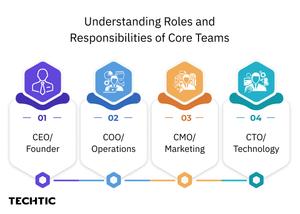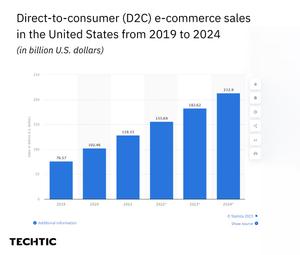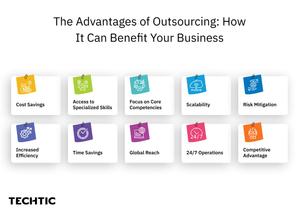Consider Culture, Team & Technology Arms While Crossing ~$1MM ARR for DTC/B2C Brands
Sector: Digital Commerce
Author: Nisarg Mehta
Date Published: 10/30/2023

Contents
Reaching a million dollars in Annual Revenue is a great milestone for any eCommerce brand. It’s a testament to the effectiveness of your business model, but it’s also a pivotal moment that requires strategic planning and a solid team to take your brand to the next level. In this blog, we will explore how to build the right team, leverage technology, and explore various marketing channels to cross the $1 million ARR threshold and set your sights on multifold growth.
The Core Teams: Their Roles and Responsibilities

- CEO/Founder: The founder of the company at this point has not only become the chief executive officer but more like a chief everything officer, filling the voids of all the open positions and using the insights gained from experience of reaching thus far to build the right people, who share the vision. The founder also has to lay down a strategic plan, goals and identify the right people to consider working for the brand towards the upcoming growth.
- COO/Operations: The COO focuses on efficiency, ensuring orders are fulfilled promptly, and also helps the brand towards supply chain and supplier management. They also manage inventory and streamline internal processes.
- CMO/Marketing: The CMO designs marketing campaigns, conducts market research, and analyzes data to make informed decisions. They’re responsible for brand awareness, customer acquisition, media management and revenue growth.
- CTO/Technology: The CTO oversees the technology stack, platform partnerships and infrastructure management. The CTO has to find and manage the right development team, and ensure the website’s performance, customer experience and security. They also evaluate and implement new technologies to stay ahead of the game.
Hiring for Cultural Fit and Scalability
Building the leadership team is not just about finding the most qualified individuals; it’s also about finding people who align with your brand’s culture and values. As your eCommerce brand scales, these leaders will be instrumental in maintaining the ethos that sets you apart from the competition.
Additionally, consider scalability when hiring for these roles. Look for individuals who have experience not only in managing teams but also in scaling operations. They should be adaptable and ready to pivot as your eCommerce brand grows and faces new challenges.
Marketing and Sales Teams
Your eCommerce DTC/B2C brand’s marketing and sales teams are the engines that drive customer acquisition and revenue growth. In this section, we’ll delve into the essential aspects of these teams:
A. In-house vs. Outsourced Marketing
- In-house marketing involves building a team of marketing professionals within your organization. These individuals are dedicated to your brand, possess an in-depth understanding of your products and target audience, and work closely with other departments.
- Outsourcing marketing services to agencies can provide access to specialized expertise without the need for in-house hiring. This approach is often more flexible and cost-effective, especially for smaller businesses.
B. Digital Marketing and eCommerce Specialists

Crossing the $1 million Annual Recurring Revenue (ARR) milestone is a significant achievement for any eCommerce Direct-to-Consumer (DTC) or Business-to-Consumer (B2C) brand. One of the pivotal factors contributing to this success is the strength of your marketing team. While building your eCommerce team for $1MM ARR, focus on,
- Digital marketing encompasses various strategies, such as SEO, content marketing, email marketing, social media marketing, and pay-per-click advertising. Your marketing team should include specialists in these areas who can develop and execute effective digital marketing campaigns to drive traffic and conversions.
- These individuals have a deep understanding of the eCommerce landscape. They focus on optimizing the online shopping experience, improving product listings, and implementing conversion rate optimization strategies to increase online sales.
C. Sales Teams and Strategies
In the DTC/B2C space, eCommerce sales teams work on optimizing the online shopping experience, upselling, cross-selling, and ensuring a smooth checkout process. Your sales teams should have well-defined strategies for customer segmentation, lead generation, nurturing, and closing deals. They should also focus on post-sale activities, such as customer retention.
D. Leveraging Technology for Data-Driven Decision-Making
Implementing data-driven decision-making tools and analytics allows you to gain valuable insights into customer behavior, optimize marketing strategies, and fine-tune your product offerings.
From eCommerce platforms with robust data analytics to customer relationship management (CRM) systems, utilizing the right tech stack empowers you to make informed decisions and drive sustainable growth.
Financial & Administrative Teams
Behind the scenes, your financial and administrative teams ensure that the gears of your eCommerce DTC/B2C brand keep turning smoothly. Here’s a brief glimpse into their roles:
A. CFO/Finance Team
The CFO is responsible for managing your company’s financial health, overseeing financial reporting, budgeting, and ensuring efficient resource allocation to support growth.
These professionals assist in data analysis, financial forecasting, and risk assessment, providing valuable insights for strategic decision-making.
B. Legal and Compliance
Your legal team or counsel deals with contracts, intellectual property protection, and compliance with regulations, safeguarding your brand’s legal interests.
These experts monitor adherence to industry regulations and legal requirements, mitigating legal risks and ensuring ethical practices.
C. HR and Talent Management
HR professionals oversee employee recruitment, onboarding, and management. They also foster a positive workplace culture and handle employee relations.
A dedicated team focuses on ongoing training and development programs, helping your employees acquire and hone skills that drive your eCommerce brand’s growth.
D. Budgeting and Financial Planning
These experts develop and manage budgets, allocate resources efficiently, and track financial performance to ensure that the company’s finances are aligned with its goals.
Financial planners create strategies for short-term and long-term financial objectives, helping your brand achieve financial stability and future growth.
Your financial and administrative teams provide the financial stability and structure needed to support your eCommerce brand’s growth. By managing finances, legal aspects, human resources, and planning effectively, they contribute to your brand’s long-term success.
Cultivating Brand Culture
A strong brand culture is the glue that holds your team together and shapes your brand’s identity. It’s vital to:
- Define and communicate your brand’s core values.
- Encourage transparency, open communication, and a sense of ownership among team members.
- Foster a culture of innovation, continuous improvement, and calculated risk-taking.
- Emphasize a customer-centric approach in all activities.
- Embrace diversity and inclusion to bring fresh perspectives and ideas into your brand.
Outsourcing & Remote Teams
In today’s interconnected world, the traditional way of building and managing teams is undergoing a transformation. eCommerce DTC/B2C brands are increasingly turning to outsourcing and remote teams to tap into specialized skills, reduce costs, and remain agile in a rapidly evolving landscape. In this section, we’ll explore the benefits and considerations of embracing these alternative team models.
A. Identifying Tasks Suitable for Outsourcing
Outsourcing isn’t an all-or-nothing proposition. Begin by identifying tasks and functions that can be effectively outsourced. This may include customer support, content creation, digital marketing, or even aspects of product development. Consider what aligns with your brand’s core competencies and where external expertise can add value.
B. Benefits of Outsourcing

- Cost Savings: Outsourcing can be cost-effective, as it often eliminates the need for full-time, in-house employees and associated expenses like office space and benefits.
- Specialization: Outsourcing allows you to tap into the expertise of specialists or agencies who excel in specific areas, such as SEO, graphic design, ecommerce store development or customer support.
- Scalability: Easily scale up or down as needed, without the overhead costs or complexities of hiring and firing employees.
C. Managing and Collaborating with Remote Teams
Building a remote team or working with outsourced partners requires a different approach to team management. Key considerations include:
- Communication: Invest in robust communication tools and establish clear communication protocols to bridge geographical gaps.
- Cultural Sensitivity: Be aware of cultural differences and adapt your management style to create a cohesive team dynamic.
- Project Management: Utilize project management software to track progress and ensure tasks are completed on time.
D. Implementing the Pod Model for Efficiency
The pod model, which organizes teams into smaller, cross-functional units, can enhance efficiency in remote and outsourced setups. Pods are self-contained and empowered to make decisions, fostering faster response times and greater autonomy.
By strategically integrating the pod model into your remote or outsourced teams, you can strike a balance between efficiency and control, making it easier to manage and scale your eCommerce brand.
Challenges & Pitfalls in Team Building and Management
While building and managing teams for your eCommerce DTC/B2C brand can be a rewarding endeavor, it’s not without its challenges and potential pitfalls. Let’s examine some of the common obstacles you might encounter and strategies for navigating them:
A. Common Challenges in Team Building and Management
- Finding the Right Talent: Identifying individuals who not only possess the necessary skills but also align with your brand’s culture can be a daunting task.
- Cultural Differences: In diverse teams, managing cultural differences in communication styles, work ethic, and decision-making can pose challenges.
- Retention and Turnover: High turnover rates can disrupt team dynamics and increase recruitment costs, especially in competitive industries.
B. Navigating Cultural Differences in Remote Teams
- Communication Barriers: Language barriers and differences in communication styles may hinder effective collaboration in remote teams.
- Time Zone Challenges: Coordinating work across different time zones can be tricky, impacting project timelines and responsiveness.
- Building Trust: Building trust in remote teams can take longer due to limited face-to-face interactions.
C. Maintaining Team Cohesion and Communication
- Remote Isolation: Remote teams may feel isolated, affecting team morale and collaboration.
- Effective Communication: Maintaining open and effective channels of communication is essential to prevent misunderstandings and misalignment.
To overcome these challenges, a proactive and adaptable approach to team management is crucial. Strategies such as clear communication, ongoing training, and fostering a culture of inclusivity and trust can help mitigate these common pitfalls.
Scaling Responsibly
A. Monitoring Team Performance and KPIs
- Key Metrics: Continuously track KPIs related to sales, customer acquisition, and team productivity to gauge progress.
- Regular Assessment: Conduct regular performance assessments and provide training and support to teams to maintain high standards.
- Sustainable Practices: Prioritize sustainability in your operations, supply chain, and product offerings to align with modern consumer values.
B. Adjusting Team Structure
- Scalability: Ensure that your team structure is scalable, capable of accommodating growth without sacrificing efficiency or quality.
- Adaptability: Be ready to reevaluate and adjust teams and strategies as your eCommerce brand evolves.
C. Preparing for the Next Phase of Growth
- Innovation: Encourage innovation within your teams to stay ahead of industry trends and customer expectations.
- Market Research: Invest in market research to identify new opportunities and areas for expansion.
By scaling responsibly, you can achieve sustainable growth that not only benefits your bottom line but also maintains the integrity of your brand and the satisfaction of your customers.
Conclusion
In the world of eCommerce, success hinges on the strength and effectiveness of your teams. As we conclude our exploration of team building and management for scaling your eCommerce DTC/B2C brand, let’s recap the essentials.
Your leadership team, marketing and sales experts, eCommerce development and operations teams, and financial and administrative units form the core of your brand’s growth engine. Finding the right talent and maintaining cultural alignment are crucial elements of success.
Your brand’s growth story is an ever-evolving narrative shaped by your teams, innovations, and strategic decisions. With the right teams and a commitment to responsible growth, your eCommerce DTC/B2C brand is poised for a bright future in the dynamic eCommerce landscape.
Are you ready to take your eCommerce business to the next level? At Techtic, we understand the challenges and opportunities in the dynamic world of online business. We’re not just an eCommerce agency; we’re your dedicated partner in success.
Partner with Techtic and watch your online business flourish. Get in touch with us today to discuss how we can elevate your eCommerce game and drive your success to new heights. Your success is our mission!
FAQs
1. How can I determine whether to build my eCommerce team in-house or outsource?
- Assess your brand’s specific needs and budget constraints.
- Consider outsourcing for specialized tasks and in-house teams for core functions.
- Strike a balance that aligns with your brand’s growth trajectory.
2. What are the key performance indicators (KPIs) I should monitor for my marketing and sales teams?
Track metrics like conversion rates, customer acquisition cost (CAC), customer lifetime value (CLV), and return on ad spend (ROAS). Adapt KPIs to your specific goals and marketing channels.
3. What's the importance of sustainability in scaling my eCommerce brand?
Sustainability aligns with modern consumer values and can be a competitive advantage. Sustainable practices contribute to brand reputation and long-term growth.
4. How can I adapt my team structure as my eCommerce brand grows?
Continuously assess team performance and workload. Be prepared to hire, delegate, or reorganize teams to accommodate growth.
5. What role does innovation play in scaling an eCommerce brand?
Innovation keeps your brand relevant and competitive in a rapidly changing market. Encourage a culture of innovation within your teams, fostering creativity and problem-solving.
Latest Tech Insights!
Join our newsletter for the latest updates, tips, and trends.







